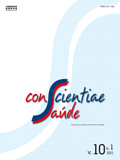Infants’ behavior in the side-lying and the influence of and additional load to the wrist
DOI:
https://doi.org/10.5585/conssaude.v10i1.2461Keywords:
Child Development, Infant, Intervention.Abstract
Introduction: Several studies on the behavior of infants in different postures. However, few have investigated the lateral position, a posture that is often used in physical therapy early stimulation, and also the effects of adding weight to segments. Objective: This study aimed to evaluate the behavior of the infant in lateral recumbency, with and without added weight. Materials and Methods: We studied 6 healthy infants evaluated according to the Alberta Infant Motor Scale, and then placed on a gurney for filming of the conduct in 3 phases: I (pre-weight), II (excess weight = 20% of the mass of the upper limb) and III (post-weight), lasting two minutes each. We observed the hand-mouth coordination, joins hands and scope. Stimulation was performed by means of soft toys. Results: We found that the conduct of range, joining hands and hand-mouth coordination in the lateral position were positively influenced by addition and removal of weight.Downloads
Downloads
Published
2011-03-31
How to Cite
1.
Araujo DM, Sande LAP de S, Fernandes LFRM, Pereira K. Infants’ behavior in the side-lying and the influence of and additional load to the wrist. Cons. Saúde [Internet]. 2011 Mar. 31 [cited 2025 Jun. 20];10(1):151-9. Available from: https://periodicos.uninove.br/saude/article/view/2461
Issue
Section
Cases studies
License
Copyright (c) 2011 ConScientiae Saúde

This work is licensed under a Creative Commons Attribution-NonCommercial-ShareAlike 4.0 International License.
Views
- Abstract 113
- PDF (Português (Brasil)) 87








